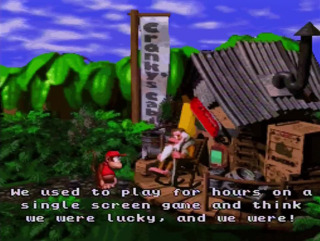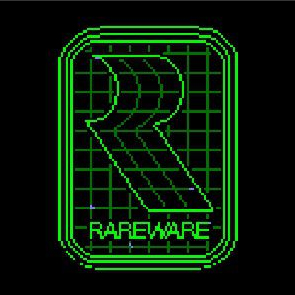Donkey Kong Country 20th Anniversary Retrospective
Going back to the country.
The original Donkey Kong was the first video game designed solely by Shigeru Miyamoto, the legendary and influential developer responsible for a significant number of Nintendo's most popular games and series, including Mario Bros. and The Legend of Zelda. The success of the Donkey Kong arcade game in 1981 jump-started Miyamoto's career at Nintendo, and it gave the company a valuable property to build future franchises from. Donkey Kong saw two sequels at the hands of Miyamoto, Donkey Kong Jr. in 1982 and Donkey Kong 3 in 1983, but the series went dormant until 1994 while Nintendo expanded its creative horizons.
A few months after Donkey Kong was released on the Game Boy in June of 1994 (a version which actually very different gameplay than its namesake), Donkey Kong debuted on the Super Nintendo in November, just in time for the holidays. At the time, Donkey Kong wasn't the sort of series you'd expect to bring in massive sales, but what Nintendo and the talented team at Rare (GoldenEye 007, Banjo-Kazooie, and Battletoads) managed to create was one of the most creative and visually appealing platformers of the day: Donkey Kong Country. Its use of animated sprites derived from prerendered 3D character models that set it apart from its contemporaries. It also featured highly creative level design for a platformer, and one of the best soundtracks of its generation.
Sclash - Console Release Date Trailer Kingdom Come: Deliverance 2 - Official Cinematic Announcement Trailer Stellar Blade - BIBI ‘Eve’ Official Music Video Trailer | PS5 Apex Legends: Urban Assault Collection Event Trailer Total War: WARHAMMER III - Elspeth von Draken Gameplay Showcase Genshin Impact - "Arlecchino: Sleep in Peace" | Official Character Teaser Potionomics: Masterwork Edition - Official Announcement Trailer Snowbreak: Containment Zone - "Gradient of Souls" Version Trailer Harold Halibut GameSpot Video Review Nancy Drew: Mystery of the Seven Keys | World Premiere Official Trailer Modern Warfare III & Warzone - Official Cheech & Chong Bundle Gameplay Trailer SteamWorld Heist II – Official Reveal Gameplay Trailer
Please enter your date of birth to view this video
By clicking 'enter', you agree to GameSpot's
Terms of Use and Privacy Policy
The original Donkey Kong Country went on to sell more than 8 million copies worldwide, making it the second-best-selling game on the Super Nintendo. Its success led to two more games on the platform, and numerous sequels on other systems, including the recently released Donkey Kong Country Returns: Tropical Freeze on the Wii U.
Here's what a few of us at GameSpot remember about the original Donkey Kong Country, which will be celebrating its 20th anniversary later this year in November...
Shaun McInnis
Remember that first stage in Donkey Kong Country? How if you turned left instead of right there would be an extra life waiting for you back inside DK's jungle abode? That was the type of game Donkey Kong Country was. On the surface, you had this vibrant and lively platformer, a game that immediately grabbed your eye with the way it employed 2D sprites of 3D renders in a way that felt cutting edge at the time. But it was also a deviously clever game, hiding away little secrets all throughout its superbly designed stages. That balloon floating in DK's home was just the tip of the iceberg.

Growing up, I spent a lot of time watching games rather than playing them. I suppose that's what happens when you have two older siblings, both of whom are loath to pass the controller to their whiny little brother. But for whatever reason, Donkey Kong Country was one of the first games where my older brothers finally took a chance and allowed me to play alongside them. No longer would I have to steal away time with our Super Nintendo when they were busy; we played together as a team.
Of course, I was relegated to playing as Diddy, but I didn't mind. Diddy was the agile one, the one who could leap higher and explore levels more thoroughly. Together, we trekked through jungles and caverns, riding atop rhinos and ostriches, looking for all those wonderful little secrets that Rare so cleverly tucked away beneath the game's simple veneer. I embraced the role of Diddy with all the zeal of youth, jumping up high and grabbing those hidden items while my brothers took turns as DK, he of the macho ground smash and dashing tie. There are few games I look back on quite so fondly as Donkey Kong Country. It was a watershed moment, and a big reason you see my name here on GameSpot today.
Tom Mc Shea
If my childhood self could have designed a video game, it would have been Donkey Kong Country. Always fascinated by simian stars, I would have gladly plopped the necktied one in the hero role instead of that fatso Mario, and even in my early teenage years, I was drawn toward infectious gaming scores. I can still hear that main theme whenever I close my eyes, or the serene underwater song as I glided atop Enguarde. Plus, platformers have been my favorite genre for almost 30 years, so this game seemed to be designed just for me.

And I loved it. How could I not? I spent hours collecting precious bananas, barreling through kremlings as the squirrelly Diddy Kong as I sought out every stray puzzle piece. I was enraptured, enthralled, entertained, excited, and every other positive adjective that begins with an "e."
A couple of years ago, I returned to Donkey Kong Country. I was transported to my younger days when that opening music began, and could not wait to set off on another adventure with my monkey friends. But that joy soon evaporated. My younger self was less discerning, more easily wooed by monkeys and music, but my older self couldn't look past the issues endemic to this game. Everything was as outstanding as I remembered--including the level design and graphical flourishes--but the controls, the very foundation of the journey, faltered. It was a struggle to move. So I sighed and moaned and put down the controller with sadness.
Donkey Kong Country remains a beacon of happiness in my memory. However, I can no longer return to it. Thankfully, Retro Games has done a remarkable job of bringing those feelings to the modern era. Donkey Kong Country Returns and Tropical Freeze not only remind me of what I loved about the originals, but are actually fun in their own right. So I'm glad that I still have great games to turn to when I need my monkey fix.
Peter Brown
Donkey Kong was always on the periphery of my childhood gaming experiences. I occasionally played--and consistently failed at--the original arcade game, and I had a friend who owned Donkey Kong Jr. on the Nintendo Entertainment System, but I wasn't a fan of Nintendo's star ape until Donkey Kong Country hit the Super Nintendo. I'll always remember the first time I saw Cranky Kong during the game's opening cinematic, appropriately cranking an antique record player atop the familiar red girders from the original Donkey Kong. Then, Donkey Kong and his boombox busted onto the scene to music by David Wise that I can't even begin to categorize, knocking Cranky Kong to the ground. Why did Donkey Kong have it out for Cranky? Where did he get that boombox? But more importantly, how did this game look so good?

It may not look like much now, but at the time, Donkey Kong Country's prerendered, faux 3D sprites were the most impressive console graphics I had ever seen. They weren't realistic by any measure, but they were far less abstract than the typical, cartoony sprites of the day. Later levels introduced weather and strong lighting to create an atmosphere of doom and gloom, and I bought into it wholesale.
It's worth noting that I was a Sega Genesis kid, and I had to go to a friend's house to play Donkey Kong Country. It was a blessing that its tag-team multiplayer feature was so strong; I never felt like a mooch when we both got to play, and having a partner in crime allowed us to finish the game without resorting to Game Genie. I didn't stick with Donkey Kong Country through the entire trilogy of games, but I always remember the first time I laid eyes on those sweet, sweet Silicon Graphics visuals.
What are your fondest memories of the Donkey Kong Country series? Let us know in the comments below!
Got a news tip or want to contact us directly? Email news@gamespot.com
Join the conversation